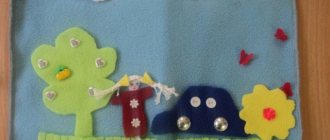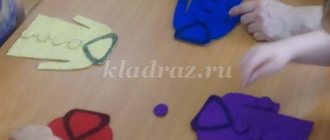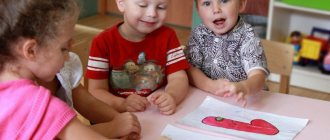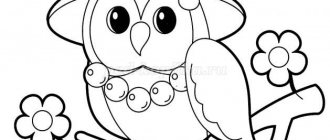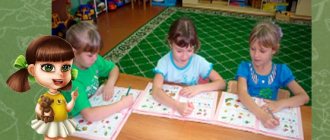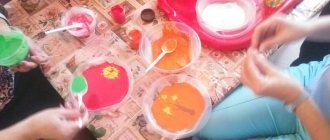Development of fine motor skills in the hands of preschool children through non-traditional drawing techniques
Development of fine motor skills in the hands of preschool children through non-traditional drawing techniques 1. Relevance. At all stages of a child's life, hand movements play a vital role. The degree of development of a child’s fine motor skills determines the most important qualities for his future: speech abilities, attention, spatial coordination, concentration and imagination. The brain centers responsible for these abilities are directly connected to the fingers and their nerve endings. Therefore, exercises and activities that involve the little fingers of a preschooler are extremely important for his mental and mental development. Fine motor skills, sensory skills, coordination of movements are key concepts for the preschool period. Fine motor skills
- This is a motor activity that is caused by the coordinated work of the small muscles of the hand and eye.
Scientists have proven that the greater the skill in a child’s hand, the more varied the hand movements, the more perfect the functions of the nervous system. This means that the development of the hand is closely related to the development of speech and thinking of a preschooler. It is necessary to begin the development of fine motor skills from early childhood. For example, through various finger games, where it is necessary to perform certain movements in a certain sequence; playing with small objects that are difficult to handle; games where you need to take something or pull it out, squeeze it - unclench it, pour it - pour it, pour it in - pour it out, push it into holes, etc.; fastening and unfastening zippers, buttons, dressing and undressing, etc. Fine motor skills of the hands are also developed by physical exercises (these are various hangings and climbing at a sports complex, on a ladder, etc.). Such exercises strengthen the baby’s palms and fingers and develop muscles. One of the effective forms of developing fine motor skills of the hands is visual activity
.
Drawing plays a special role. Children draw with tools that are similar in shape, way of holding and action to the pen they use to write at school. From children's drawings you can trace how fine motor skills develop and what level they reach at each age stage. Of course, while mastering drawing, sculpting, and appliqué, a child will not learn to write. But all these types of productive activities make the baby’s hand skillful, easily and freely controlling the instrument, and develop visual control of hand movements. Helps form the hand-eye connection. All this will be a good helper for him at school. The problem of developing fine motor skills in preschool age is very relevant, since it is precisely this that contributes to the development of sensorimotor skills - consistency in the work of the eye and hand, improvement of coordination of movements, flexibility, accuracy in performing actions, correction of fine motor skills of the fingers. The visual activity of a child in preschool age is one of the natural, specifically children's activities.
In the process of managing it, the opportunity to solve a wide range of problems of an educational nature opens up.
Observing the activities of young children in direct organized and independent activities and analyzing them, I identified the need for the development of fine motor skills. The children had underdevelopment of fine motor skills and hand-eye coordination: clumsiness, uncoordinated hands. The children got tired quickly and had low performance. The children who came to the group were “home children”; they did not have developed self-care skills. Despite the fact that for work on the development of fine motor skills in the group, an appropriate developmental environment has been created: a varied content of materials in the sensory center: (mosaics, bushings, pyramids, sticks, various didactic games, etc.), the construction center (construction sets, floor mosaics, different textured toys, waste material, etc.), theater and music center (finger theaters, twitchers, dolls of different textures, etc.), diagnostic results to determine the level of development of children’s fine motor skills could not meet the expectations from the use of the presented material. The level of development of children's fine motor skills increased by a small percentage. Therefore, there is a need to pay attention to this problem. 2. Theoretical justification.
For a detailed study of the problem, I turned to the works of L.V.
Antakova-Fomina, M.M. Koltsova, B.I. Pinsky, T.S. Komarova, B.M. Teplova et al. The issue of developing fine motor skills in children is relevant at all age stages of preschool childhood. This is repeatedly emphasized by teachers, psychologists and other specialists in the field of preschool education. According to research conducted by L.V. Antakova-Fomina, M.M. Koltsova, B.I. Pinsky confirmed the connection between intellectual development and finger motor skills. The level of development of children's speech is also directly dependent on the degree of formation of fine hand movements. The area of fine motor skills includes a wide variety of movements: from primitive gestures, such as grasping objects, to very small movements, on which, for example, human handwriting depends. Fine motor skills develop naturally from infancy on the basis of gross motor skills. First, the child learns to grab an object, then the skills of shifting from hand to hand, the so-called “tweezer grip,” etc. appear; by the age of two, he is already able to draw and hold a brush and spoon correctly. In preschool and early school age, motor skills become more diverse and complex. The proportion of actions that require coordinated actions of both hands is increasing. ON THE. Bernstein in his theory shows that the anatomical development of the levels of movement construction begins from the first months of life and is completed by two years. Then begins a long process of adjusting all levels of movement construction to each other. The development of cognitive abilities in connection with the development of hand movements is especially active in infancy and early age due to the fact that the movements of the hand examining various objects is a condition for the child’s knowledge of the objective world. “Direct practical contact with objects, actions with them lead to the discovery of more and more new properties of objects and relationships between them” (D.B. Elkonin). N.A. Bernstein emphasizes that the conditions of upbringing and targeted training that promote the development of hand movements are decisive for the effective development of a child’s fine motor skills. The motor tasks that an adult sets for a child in the process of education, and the child’s attempts to solve them, are a necessary condition for the development of appropriate levels of movement construction. Thus, various tasks for fine motor skills contribute to the development of fine movements of the hands and fingers. Fine motor skills
are a set of coordinated actions of the nervous, muscular and skeletal systems, often in combination with the visual system in making small and precise movements of the hands and fingers and toes.
The term dexterity is often used when referring to motor skills of the hand and fingers. There are a huge number of games and exercises that develop small muscles. They can be divided into several groups
:
games for the development of tactile perception
,
games with water and sand
,
folk finger games
,
exercises with objects
,
laying out games
,
stringing games
,
games with construction sets
, etc.
It is believed that all games and exercises that are carried out with children in an interesting, relaxed playful way, involving parents in this process, help develop the fine motor skills of children’s hands, their speech, attention, thinking, and also give them joy and pleasure. In addition to games and exercises, various types of productive activities also contribute to the development of manual skills: drawing, modeling, appliqué, designing, weaving, knitting, etc. Productive activities, including drawing, play an important role in the mental development of a child. B.M. Teplov writes that “the task of depicting necessarily requires acute perception, a genuine sense of things... By solving the task of depicting what is seen, the child inevitably learns to see things in a new, much sharper and more accurate way.” Interest in children's drawings arose in the 80s of the 19th century, and scientists from various fields continue to study it to this day. By analyzing children's drawings, art critics look for confirmation of their concepts. Teachers outline the most effective ways to teach and educate preschoolers. Psychologists, using the method of qualitative and quantitative analysis of not only the drawing, but also the process of depiction itself, study the general and individual characteristics of children. Doctors and psychotherapists believe that the process of drawing has a positive effect on the central nervous system and has a psychocorrective effect on the child. It is closely connected with visual, motor, muscular-tactile analyzers, with kinesthetic sensations, muscular-articular work of the hand and fingers, and the mechanism of visual-motor coordination. With the help of vision, the child perceives color, shape, size, position of an object in space, and thanks to touch, he learns volume and texture. In cases where an object cannot be picked up, the muscular sense is activated: tracing the outline of an object in the air helps in the future when depicting it, since this movement is stored in memory (T.S. Komarova and others). In the process of drawing, children learn to reason and draw conclusions. Their vocabulary is enriched. Working with visual material, finding successful color combinations, recognizing objects in a drawing, children receive satisfaction, they have positive emotions, and the work of their imagination is enhanced. Thanks to drawing activities, visual-motor coordination develops, hand functions develop, and fine motor skills of the hands and fingers improve. The inclusion of non-traditional methods of drawing and creative design in working with children makes it possible to develop the sensory sphere not only through studying the properties of depicted objects and performing appropriate actions, but also through working with various painting materials. In addition, the child’s cognitive interests are stimulated (using objects that surround the child every day from a new perspective - you can draw with your own palm, fingers, use a spikelet or birch leaf instead of brushes). There is a development of visual - figurative and verbal - logical thinking, activation of children's speech activity (what else can I draw?, What can I draw with this material?). Through the use of a variety of visual materials, new technical techniques that require precision movements, but do not limit the child’s fingers to a fixed position (as when holding a pencil correctly), conditions are created to overcome general inconvenience and develop fine motor skills. After all, instead of a traditional brush and pencil, the child uses his own palms, various prints, stencils, “blotography”, “monotype” techniques, etc. to create an image. Unconventional drawing is the art of depicting without being based on tradition.
Drawing in unconventional ways is a fun, mesmerizing activity that surprises and delights children.
Unusual materials and original techniques attract children because the word “No” is not present here, you can draw with whatever you want and how you want, and you can even come up with your own unusual technique. Children feel unforgettable, positive emotions, and by emotions one can judge the child’s mood, what makes him happy, what makes him sad. It is non-traditional drawing techniques that create an atmosphere of ease, openness, promote the development of initiative, independence, and create an emotionally favorable attitude towards activities in children. The result of visual activity cannot be good or bad; each child’s work is individual and unique. Thus, a theoretical analysis of the literature on the topic helped to draw the following conclusions
:
- An analysis of psychological and pedagogical literature on the problem of developing fine motor skills in young children shows that the development and improvement of fine motor skills of the hand and fingers is the main stimulus for the development of the central nervous system, all mental processes, and speech.
- The development of fine motor skills is not a spontaneous, independently occurring process, but specially created conditions for education and targeted training that promote the development of hand movements.
- The inclusion of non-traditional drawing methods in working with children makes it possible to develop the sensory sphere not only through studying the properties of depicted objects and performing appropriate actions, but also through working with various painting materials, thereby stimulating the child’s cognitive interests.
Methodological content of the work.
As a result of studying various proprietary methods of early childhood development and the psychological characteristics of children 2-3 years old, I built a system of work on the problem of developing fine motor skills in young children through non-traditional drawing techniques.
When working on the system, I relied on the existing developments of T.S. Komarova. and Gerbova V.V., Lykova A.I. in visual arts. Purpose of the work:
to create conditions for the development of fine motor skills in preschool children through non-traditional drawing techniques.
Main goals:
- Development and strengthening of fine motor skills.
- Expanding the understanding of the variety of non-traditional drawing techniques.
- Training in non-traditional drawing techniques.
- Creating a developmental environment for children to express themselves in creative activities.
- Leading children to create an expressive image when depicting objects and phenomena of the surrounding reality.
Expected results:
- Dynamics of development of fine motor skills.
- Application of the studied techniques, techniques and materials in direct artistic - educational and independent activities.
- Replenishment of the art center with various waste materials for use in direct artistic - educational and independent activities.
Work on developing fine motor skills in preschool children through non-traditional drawing techniques is carried out with a subgroup of children. In many ways, the result of a child’s work depends on his interest, so it is important to intensify the preschooler’s attention in activities and encourage him to further actions with the help of additional incentives. Such incentives could be:
- play, which is the main activity of children;
- a surprise moment - a favorite fairy tale or cartoon character comes to visit and invites the child to go on a trip;
- asking for help, because children will never refuse to help the weak, it is important for them to feel significant;
- musical accompaniment;
- bright, well-thought-out visualization, etc.
In my work I used the accumulated experience in this area and the basic principle of didactics: “from simple to complex.” The system of work on the use of non-traditional drawing techniques has the following structure. Block 1 - “Tactile drawing”:
“Finger painting” the child dips his finger in the gouache and puts dots and specks on the paper.
Each finger is painted with a different color. After work, wipe your fingers with a napkin, then the gouache is easily washed off. “Painting with the palm”: the child dips his palm in gouache (the entire brush) or paints it with a brush and makes an imprint on paper. They draw with both the right and left hands, painted in different colors. After work, wipe your hands with napkins, then the gouache is easily washed off. “Bitmap” the child dips his finger in the gouache, places it perpendicular to a white sheet of paper and begins to draw. Block 2 – “Use of additional means of expression”:
“Imprinting with seals from cork or an eraser” Method of obtaining an image: the child presses the cork to a stamp pad with paint and makes an imprint on the paper. To obtain a different color, both the bowl and the stopper are changed. “Stencil printing” Method of obtaining an image: the child presses a signet or foam rubber swab onto a stamp pad with paint and makes an impression on paper using a stencil. To change the color, take another swab and stencil. “Ordinary blotography” Method of obtaining an image: the child scoops up gouache with a plastic spoon and pours it onto paper. The result is spots in a random order. Then the sheet is covered with another sheet and pressed (you can bend it in half, drip mascara on one half, and cover it with the other). Next, the top sheet is removed, the image is examined: it is determined what it looks like. The missing details are completed. “Blotography with a tube” Method of obtaining an image: a child scoops up paint with a plastic spoon, pours it onto a sheet, making a small spot (droplet). Then blow on the stain from a tube so that its end does not touch either the stain or the paper. If necessary, the procedure is repeated. The missing details are completed. “Imprint with crumpled paper” Method of obtaining an image: a child presses crumpled paper to a stamp pad with paint and makes an imprint on the paper. To get a different color, both the saucer and the crumpled paper are changed. “Bitmap” To implement it, you can take a felt-tip pen, a pencil, place it perpendicular to a white sheet of paper and start drawing. But the best thing to do is dotted drawings with paints. A cotton swab is dipped into thick paint. And then the principle of drawing dots is the same. “Spraying” Method of obtaining an image: the child puts paint on a brush and hits the brush on the cardboard, which he holds above the paper. Then he paints the sheet with watercolors in one or more colors. Paint splashes onto the paper. “Leaf prints” Method of obtaining an image: a child covers a tree leaf with paints of different colors, then applies it with the painted side to the paper to obtain a print. Each time a new leaf is taken. The petioles of the leaves can be painted on with a brush. “Foam rubber drawings” We make various small geometric figures from foam rubber, and then attach them with a thin wire to a stick or pencil (not sharpened). The tool is already ready. Now you can dip it in paint and use stamps to draw red triangles, yellow circles, green squares (all foam rubber, unlike cotton wool, washes well). “Poke with a hard semi-dry brush” Method of obtaining an image: the child dips the brush into the gouache and hits the paper with it, even vertically. When working, the brush does not fall into the water. Thus, the entire sheet, outline or template is filled. The result is an imitation of the texture of a fluffy or prickly surface. “Drawing with Crayons” Preschoolers love variety. These opportunities are provided to us by ordinary crayons, sanguine, and charcoal. Smooth asphalt, porcelain, ceramic tiles, stones - this is the base on which chalk and charcoal fit well. Thus, asphalt is conducive to a succinct depiction of subjects. And on ceramic tiles (which are sometimes leftovers stored somewhere in the pantry), we recommend drawing patterns and small objects with crayons or charcoal. Large stones (such as voluns) are asked to be decorated with the image of an animal’s head or a tree stump. It depends on what or who the stone resembles in shape. “Painting small stones” Of course, most often the child draws tiles of large stones on a plane, on paper, less often on asphalt. A flat image of a house, trees, cars, animals on paper is not as attractive as creating three-dimensional creations of your own. In this regard, sea pebbles are ideally used. They are smooth, small and have different shapes. The very shape of the pebble will sometimes tell the child what image to create in this case (and sometimes adults will help the kids). It’s better to paint one pebble as a frog, another as a bug, and the third will make a wonderful fungus. Bright, thick paint is applied to the pebble - and the image is ready. It’s better to finish it like this: after the pebble has dried, cover it with colorless varnish. In this case, a voluminous beetle or frog made by children’s hands shines and shimmers brightly. This toy will take part in independent children's games more than once, and will bring considerable benefit to its owner. “Nitcography method” First, a screen measuring 25x25 cm is made from cardboard. Either velvet paper or plain flannel is glued onto the cardboard. It would be nice to prepare a cute bag with a set of woolen or half-woolen threads of various colors for the screen. This method is based on the following feature: threads with a certain percentage of wool are attracted to flannel or velvet paper. You just need to attach them with light movements of your index finger. From such threads you can prepare interesting stories. Imagination and sense of taste develop. Girls especially learn to skillfully select colors. Some thread colors suit light flannel, and completely different ones suit dark flannel. Thus begins the gradual path to women’s craft, a very necessary handicraft for them. “Drawing on wet paper” But there are a number of objects, subjects, images that are better to draw on wet paper. Clarity and vagueness are needed, for example, if a child wants to depict the following themes: “City in the fog,” “I had dreams,” “It’s raining,” “City at night,” “Flowers behind the curtain,” etc. You need to teach your preschooler to make the paper a little damp. If the paper is too wet, the drawing may not work. Therefore, it is recommended to soak a ball of cotton wool in clean water, squeeze it out and rub it either over the entire sheet of paper, or (if required) only over a separate part. And the paper is ready to produce unclear images. “Learning to make a background” Many children make a background with a brush, and an ordinary, small one. Although there is a simple and reliable way: to make a background with cotton wool or a piece of foam rubber dipped in water and paint. Block 3 – “Use of mixed techniques”: “Collage” The concept itself explains the meaning of this method: it combines several of those described above. In general, we ideally think the following is important: it is good when a preschooler is not only familiar with various image techniques, but also does not forget about them, but uses them appropriately, fulfilling a given goal. For example, one of the children decided to draw summer, and for this he uses a dot pattern (flowers), and the child will draw the sun with his finger, he will cut out fruits and vegetables from postcards, he will depict the sky and clouds with fabrics, etc. “Drawing with Postcards” In fact, almost every home has a lot of old postcards. Go through old postcards with your children, teach them to cut out the necessary images and paste them into place, into the plot. A bright factory image of objects and phenomena will give even the simplest unpretentious drawing a completely artistic design. Can a three-, four-, or even five-year-old child draw a dog and a beetle? No. But he will add sun and rain to the dog and the bug and will be very happy. Or if, together with the children, you cut out a fairy-tale house with a grandmother in the window from a postcard and paste it on, then the preschooler, relying on his imagination, knowledge of fairy tales and visual skills, will undoubtedly add something to it. “Fabric images” We collect remnants of fabrics of various designs and different qualities into a bag. As they say, both chintz and brocade will come in handy. It is very important to show with specific examples how a design on a fabric, as well as its dressing, can help to depict something in a plot very vividly and at the same time easily. Let's give a few examples. Thus, flowers are depicted on one of the fabrics. They are cut out along the contour, glued (only with paste or other good glue), and then painted on the table or vase. The result is a capacious colorful image. There are fabrics that can serve well as a house or the body of an animal, or a beautiful umbrella, or a hat for a doll, or a handbag. “Drawing together on a long strip of paper” In this case, a long strip will help two people draw without interfering with each other. You can draw isolated objects or scenes, i.e. work nearby. And then it is advisable to move on to collective drawing. The adults and the child agree on who will draw what to create one story. “Wax crayons or candle + watercolor” Method of obtaining an image: the child draws with wax crayons or a candle on paper. Then he paints the sheet with watercolors in one or more colors. The drawing remains unpainted. The structure of game sessions might look like this:
- Morning circle, including motivation of children, finger exercises (speech games, breathing exercises, etc.).
- Artistic and visual activities.
- The final circle, which includes encouraging children, telling children about work, finger gymnastics, etc.
To implement the assigned tasks, I envision close cooperation with the parents of the students. Working with parents includes :
registration of consultations on the topic of the development of fine motor skills and the use of non-traditional drawing techniques, folders - moving, information stands, display of open events on the topic, joint equipping of the group with waste materials, exhibitions of children's creativity, etc. Work with teachers includes: registration of consultations on the topic of development of fine motor skills and the use of non-traditional drawing techniques, showing open events on the topic, etc.
Conclusion.
Thus, when studying work experience, an attempt was made to find possible ways to develop and improve coordination of hand movements, visual-motor coordination and the development of fine motor skills in the process of visual activity, taking into account the age and individual capabilities of children.
From the research work carried out, we can conclude that the use of finger games and exercises, didactic games, non-traditional materials, techniques and an individual differentiated approach in activities contributed to the development of fine motor skills in children. I consider it most acceptable to use non-traditional imaging techniques in my work, because... children receive not only knowledge and skills, but also joy and pleasure. Many types of non-traditional drawing help to increase the level of development of visual-motor coordination. To correct fine motor skills of the hands, such non-traditional image techniques as drawing with hands: palm, fingers, are important. In addition, the introduction of non-traditional image techniques into practice does not tire preschoolers; they remain highly active and efficient throughout the entire time allotted for completing the task. In the group, whenever possible, I tried to create conditions for the development of fine motor skills. The available material is arranged in such a way that children can freely, based on their interests, choose aids for this type of activity, if they wish, not only reproduce and continue what they did in joint activities with the teacher, but also show their creativity, as well as finish the work they started , realize your plans in independent activities throughout the day. In my future work, I will continue to use non-traditional materials and techniques in visual arts, taking into account the age and individual characteristics of children. Used Books:
- Averina I.E. Physical education minutes and dynamic pauses in preschool educational institutions. – M.: Iris-press, 2006.
- Ruzanova Yu.V. Development of hand motor skills in non-traditional visual activities: Techniques for performing work, planning, exercises for physical education. – St. Petersburg: KARO, 2009.
- Nikitina A.V. Unconventional drawing techniques in kindergarten. planning, lesson notes: A manual for educators and interested parents. - St. Petersburg: KARO, 2010.
- G. I. Davydova “Non-traditional drawing techniques in kindergarten”, Moscow “Scriptorium Publishing House 2003”, 2008
- I. V. Tyufanova “Workshop of young artists. Development of visual abilities of older preschoolers", St. Petersburg, publishing house "Detsvo-Press", 2004.
- A. A. Fateeva “Drawing without a brush”, Yaroslavl, publishing house “Academy of Development-Academy Holding”, 2004.
- “Drawing with preschool children. Non-traditional techniques" edited by R. G. Kazakova, Moscow, publishing house "Creative Center Sphere", 2005.
- I. A. Lykova “Art activities in kindergarten”, Moscow, publishing house “Karapuz-Didactics”, 2007
- Internet materials.
Fine motor skills - what is it and how does it affect the child’s condition?
Imagine picking up a tennis ball and a grain of rice. Agree, it’s much easier and faster to grab the ball: close your fingers and you’re done. Whether it’s raising a small grain, you need to get used to it, pick up and hold this crumb.
It's all about physiology . The human hands are equipped with a large number of muscles, both large and small. We train large muscles every time we make any movements with our hands and fingers. But small muscles “rest” and do not develop until we begin to make small and precise manipulations.
Give a baby a coin - he will clutch it in his palm, no matter how interesting it is to him. But a four or five year old child will be able to pick it up with his fingers and carefully examine it. This simple difference is the effect of developed fine motor skills.
So, fine motor skills are the degree of development of the small muscles of the hands, which are used for precise and small movements. Then why develop it?
The excitement around fine motor skills began quite a long time ago, when M. Montessori, V.A. Sukhomlinsky, A.R. Luria discovered an interesting relationship: children with delayed speech development could not work with small objects, while children with a normal level of development actively used them.
This discovery became an impetus for other research in the fields of psychology, pedagogy and physiology. As a result, it was discovered that the accuracy of performing small manipulations is associated with the work of the speech parts of the brain, consciousness, thinking, spatial orientation, memory and vision.
Accordingly, by working on a child’s fine motor skills, you not only develop small hand muscles, but also train his brain, use the visual, skeletal, muscular, and nervous systems. Not a bad bonus for a caring parent, right?
